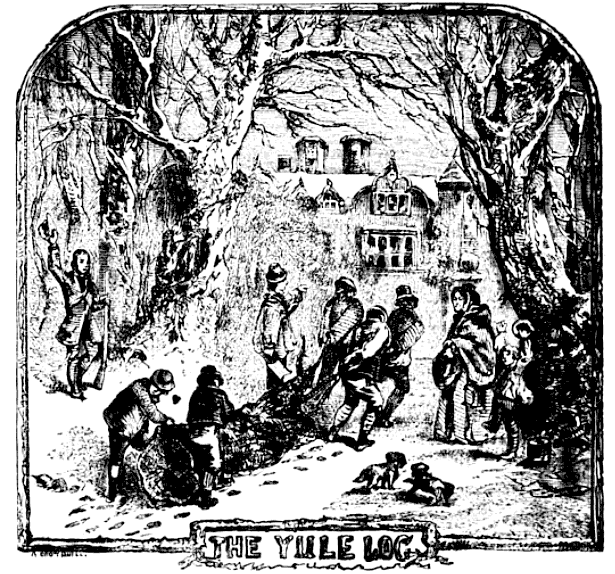By Alastair Culham

The Yule log was traditionally a large branch, trunk or whole tree brought indoors to burn slowly over the Christmas period and in to the New Year. Currently Yule coincides with the 12 days of Christmas, 21st December to January 1st. What seems unclear is how the tree was treated before Yule, some accounts suggest it was freshly harvested however the use of oak (Quercus) in England as a favoured Yule log suggests at least two years planning ahead to allow the wood to dry sufficiently to burn well! In an era where wood burning stoves have become fashionable as a chic and environmentally friendly way to heat the house, one must ask “Is wood burning really good for the environment?”

There is much interest now in the use of wood to heat homes in the UK because this is seen as a renewable fuel with a low net carbon output. Different woods are known to have different burning properties, some burn well even when freshly cut while others need two years of seasoning (drying) after cutting. One issue with wood is the carbon cost of fuel to fell it and transport it on an industrial scale – this means it is not a truly carbon neutral fuel. Another issue is that of keeping the fire burning if it is the main source of heat in the house. Views vary.
In The Guardian, a paper I thought might be promoting wood fuel Phil Daoust says “your burner will dominate your life like a newborn baby” and the cost: “Imagine 300 blue Ikea bags filled with £50 notes.”
The Telegraph focuses on the fashion value of wood burning stoves in a piece by Harry Wallop on the collection of cast off Christmas trees as a source of fuel: ” ‘You need to be quick,’ he said, as he pointed to the far end of the road at another fellow, bent double and trying to yank a base off a tree. Oh, yes: it was rutting season for the lentil-munchers of north London. ”
A decidedly positive piece on wood burning was provided by the Energy Saving Community web site which emphasized that, although wood burning is not carbon neutral it does have other environmental benefits: “One very positive aspect of the upsurge in wood burning has been its effect on biodiversity and habitat. With a growing commercial value in forestry products, managing woods has itself received a welcome shot in the arm at a time when, in many parts of the country, natural woodland habitats and the species that depend on them have been suffering from years of gradual decline.”
Ultimately wood burning has costs on air quality and carbon costs in transport so unless you have a ready source of local wood, and live in an area of low population density there are probably better ways to heat your house.
A widely quoted poem on the internet, and attributed to Honor Goodhart (Punch 1926) gives a valuable summary of the properties of many UK native timbers.
“LOGS TO BURN.”
“Logs to burn ; logs to burn;
Logs to save the coal a turn.”
Here’s a word to make you wise
when you hear the woodman’s cries;
Never heed his usual tale
That he’s splendid logs for sale
But read these lines & really learn
The proper kind of logs to burn.
Oak logs will warm you well,
If they’re old and dry.
Larch logs of pinewoods smell
But the sparks will fly.
Beech logs for Christmas time;
Yew logs heat well;
“Scotch” logs it is a crime
For anyone to sell.
Birch logs will burn too fast;
Chestnut scarce at all;
Hawthorn logs are good to last
If cut in the fall.
Holly logs will burn like wax,
You should burn them green;
Elm logs like smouldering flax,
No flame to be seen.
Pear logs and apple logs,
They will scent your room;
Cherry logs across the dogs
Smell like flowers in bloom,
But ash logs all smooth and grey
Burn them green or old,
Buy up all that come your way
They’re worth their weight in gold.
I couldn’t find the poem in Punch but a message to them generated the rapid response that it was actually published in 1920. Thank you Punch Ltd. for your time in helping me out! Since then I’ve found the original printed over two columns of page 337, October 27, 1920 (University of Reading, Senior Common Room has a run of bound editions from 1900-1979). The poem has no attribution on the page but is in the annual index under Articles on p519 (Punch, December 29th, 1920) “Goodhart, Mrs. H. Logs to Burn……p337”.
Alongside these historic aides memoires there is much modern information on which wood to use for log burning stoves and open fires. The company ‘Flaming Fires’ has published a list including many species not mentioned in the poem above and the Forestry Commission have a detailed document on choosing firewood.
References
Chambers Book of Days (1832)
Goodheart, Honor (1920) “Logs to Burn”, Punch Magazine, 27th October 1920, p 337.
